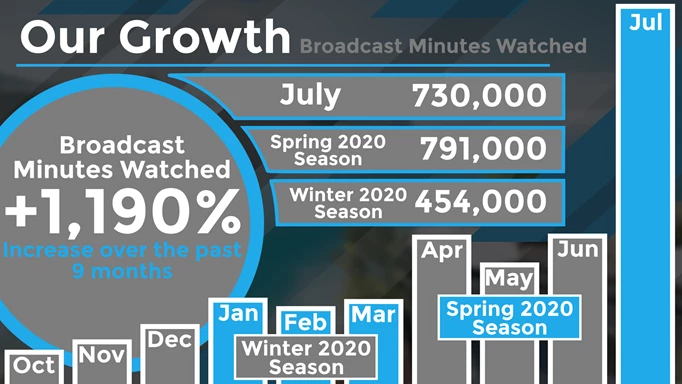Quarantine: Sports Under Siege

With the proliferation of COVID-19, there has never been a better time to get into esports as either a viewer, player, or other associated talents. Videogames of all shapes and sizes, genres and audiences have come forward and marketed themselves as a viable option for mainstream television content. This can be seen with games such as Rainbow Six: Siege, CSGO, Rocket League and League of Legends being broadcast as part of BBC Scotland’s coverage of the Scottish Esports League (SEL) finals in July.
Rainbow Six: Siege (R6:S) especially, is one of those games that lends itself to mainstream broadcast. It has the high-resolution graphics to appeal to a mainstream audience, whereas comparable games such as Overwatch, Counter-Strike: Global Offensive (CSGO) and VALORANT can look cartoony or outdated by comparison. The 5v5 format is, by now, a tried and tested formula that has stood the test of time. It stands as a technically deep and complex shooter, the mechanics of which can be as nuanced as the most complex strategic plays of NFL, of Rugby Union, of Football even! As such, R6:S stands alongside Rocket League as one of the esports that seem most compatible with the mainstream audience, but there are further benefits to Siege as a whole than just the momentary attention. Mainstream broadcast not only has the potential to bring fresh players into the game, fresh talent. It also has the chance to help advertise esports as a viable source of entertainment for the masses.
Whilst the lack of physical sports has been very noticeable over the past few months, the surge in the amount of esports coverage has been very uplifting in terms of representing how the industry can move forwards and improve. That said, uptake has been limited and viewership on mainstream broadcasts has not been high. Whilst there is a growing acceptance of the medium, esports still appear unviable as a regular, commercially viable broadcast.
The benefits are not limited to T1 competition. Grassroots leagues have seen an expansion in the T3 and T4 bracket of esports. Organisations such as the Esports Association (ESA) and European Esports Gaming (EEG) have grown in popularity and as such in size, with the time spent in lockdown. There has even been intercontinental expansion, with the unveiling of the Siege Cardinal League expanding from the North American scene to start a European competition proving that there is demand and intent behind the expansion of the game, even five years after release. To what extent this can be attributed to the quarantines as a result of COVID-19, is unclear. However, it seems apparent that the game's grassroots – the leagues that generate and train talent for the wider broadcast market - is healthy and growing.
Whilst physical sports have struggled, with governing bodies such as the Rugby Football League even admitting that it could irreparably damage the sport given the financial reliance of teams on matchday gate income, esports have prospered. ESA, an intercontinental Siege (and VALORANT) competition organisation has prospered in the past five months, showing enormous growth from season to season.

 Click to enlarge
Click to enlargeWith this expansion in viewership, Siege’s competitive scene is looking as healthy as ever. That said, the vast majority of R6:S viewers on Twitch are already heavily invested in the game. Whilst organisations such as ESA have benefited from increased viewership – it is doubtful that the increased viewership has had any relationship with player numbers. For instance, the chart below indicated that player numbers fluctuated wildly during the peak of COVID, only recovering in July to maintain parity with the average player numbers during July 2019.

 Click to enlarge
Click to enlargeWith this instability in the playerbase, it is apparent that the viewership of tournaments, both T1 and T2, came from people already invested in the game who played regularly. Whilst this is perhaps a predictable conclusion, it indicated a lack of outreach to mainstream broadcasters. Some broadcasters, such as BBC Scotland and ESPN have (as mentioned above) had some limited uptake in esports broadcasts, but the fact remains that reruns of sporting events from yesteryear are proving more popular than live esports events, even during COVID quarantines.
The ease with which tournaments and competitions have been moved online has been of tremendous help with absorbing the shock of quarantine. Naturally, offline LAN events have suffered, with familiar UK events having to move their business model online such as Epic.LAN (lovingly renamed Epic.WAN for the most recent event), or cancel and attempt to ride out the storm on savings and reputation (notably, Insomnia 67). The inability to produce live events affects every tier of the game. It stops talent from the T3 and T2 bracket from being discovered as easily, damages the ability of broadcasters, observers and producers to add big-ticket events to their CV and hurts the companies that run the events financially. Whilst events such as R6:S Pro League have coped fine with the movement to an already-established online model, offline events rely on entry fees, ticket prices not only to attract high-level talent and sponsorship but also to fund and pay for venues, for staff and other expenses. The sudden drop in revenue could well affect the offline scene for years to come.
Sports have suffered in lockdown, but it has not been a zero-sum competition between esports and sports. Whilst esports would appear to be more resilient given the presence of online play, this hasn’t translated to mainstream acceptance, and some areas of the industry have been extremely damaged by COVID. We can only hope that both recover. That said, we can still look forward to and enjoy a vibrant online esports scene, something that we can all take comfort in during such a prolonged, extended period of uncertainty.
Images Via ESA | Steamcharts.com | Ubisoft